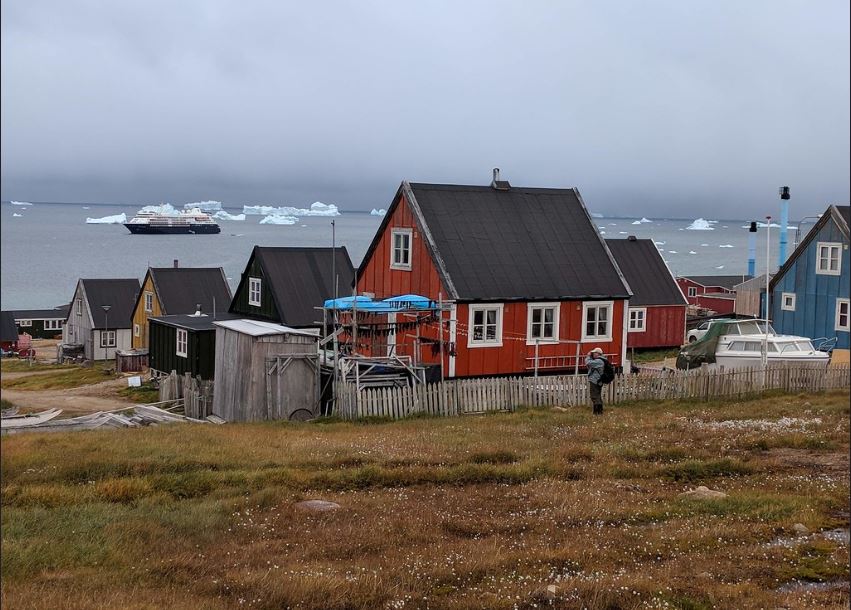
HANOVER, New Hampshire, November 12, 2019 (ENS) – Thayer School of Engineering at Dartmouth College has accepted an invitation to partner with Qaanaaq, an Arctic hunting and fishing community in northwestern Greenland, as the residents transition to renewable energy and an affordable, sustainable future.
Funded by a US$2.6 million grant from the National Science Foundation, the project is expected to produce sustainable technological solutions that will also benefit other communities facing the effects of the climate crisis, including areas in the mid-latitudes.

Formerly and still popularly known as Thule or New Thule, Qaanaaq is one of the northernmost towns in the world.
The people of Qaanaaq, many of whom make their living by hunting and fishing through sea ice, asked Mary Albert, a professor of engineering at Thayer, to collaborate with them in their transition to affordable, renewable energy. Albert has worked in Greenland for many years studying snow and climate. She knows the citizens from her previous work and has agreed to lead the new team.
The Thayer team expects to travel to Qaanaaq for two weeks in the spring and two weeks in the fall each year for the next four years starting in April 2020. Previous funding from the Arthur L. Irving Institute for Energy and Society at Dartmouth enabled the team to visit Qaanaaq earlier this year to help identify the area’s needs.
Professor Albert says their work will support the Qaanaaq residents’ hunting and fishing way of living, which is currently unsustainable.
Albert says the people of Qaanaaq are excited about the prospect of decreasing their dependence on diesel and other fossil fuels, which are expensive and unsustainable.
Today, 70 percent of Greenland’s energy is renewable hydropower from melt-fed rivers, but due to the conditions in the Qaanaaq area, many sources of sustainable energy, such as hydropower, are not feasible.
“It’s not a straightforward problem – it’s multifaceted. It involves equity, policy, the economy, ecosystems, societal culture, as well as engineering principles. All those aspects come into innovative solutions for this community,” said Albert.
Albert is confident the team, which includes research scientists, practitioners, and community members in Greenland, will be able to improve living standards as well as create sustainable solutions through the combination of technology innovation, youth education, and governmental policy change.
“In order to have a healthy community, we need to address the economic issues that accompany our energy needs and help promote a more sustainable society,” said Lene Kielsen Holm, who is the Greenland lead for the project. “Economic change would produce many beneficial side effects such as enabling more independence and bringing people back to a more balanced everyday life.”
“This project demonstrates engaged science in action,” said Stephen Doig, who contributed to the grant proposal and will travel with the research team to Greenland as research director at the Irving Institute. “It’s about understanding common goals and aspirations and then helping create and act on a plan.”

The Qaanaaq area in northwestern Greenland was first settled around 2000 BC by the Paleo-Eskimo people migrating from the Canadian Arctic.
The town of Qaanaaq was established in the winter of 1953 when the United States expanded Thule Air Base and forcibly relocated the population of two villages to the north within four days. The settlement was subsequently moved another 100 km (62 miles) north.
With 656 inhabitants as of 2013, Qaanaaq is now the largest settlement in Greenland’s far north. Its population has been stable with only minor fluctuations since the mid-1990s. With its relatively low population and tradition of hunting, the village currently has more huskies than human residents.
Qaanaaq hosts a remote Comprehensive Nuclear-Test-Ban Treaty Organization infrasound listening station called IS-18, which uses an array of barometric sensors to detect possible nuclear tests around the world. The station is maintained by the Danish Meteorological Institute.
Rounding out the Dartmouth-Qaanaaq team will be Christopher Polashenski, adjunct assistant professor of engineering, and Weiyang (Fiona) Li, an assistant professor of engineering, as well as three Thayer PhD students and a postdoctoral fellow.
“This is an amazing opportunity to link science and human needs directly,” said Polashenski. “Only by understanding the complex linkages between environmental change and human activities can we plan for our future.”
The National Science Foundation grant is part of the NSF’s 10 Big Ideas program, which identifies and invests in research areas at the frontiers of science and engineering.
Navigating the New Arctic, one of the 10 Big Ideas, recognizes that biological, physical, chemical, and social changes in the Arctic will fundamentally alter climate, weather, and ecosystems globally with profound impacts on the world’s economy and security.
Copyright Environment News Service (ENS) 2019. All rights reserved.
© 2019, Environment News Service. All rights reserved. Content may be quoted only with proper attribution and a direct link to the original article. Full reproduction is prohibited.
